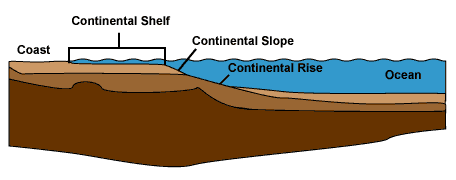Continental shelf
A continental shelf is an underwater landmass that extends outward from a continent from the coast into the seabed to depths of 100–200 metres. The average width of a continental shelf is about 65 km. The world’s largest continental shelf extends 1,500 km (about 930 miles) from the coast of Siberia into the Arctic Ocean.
A continental shelf is gently inclined seaward at an average slope of about 0.1°.
It usually ends with an abrupt drop called the shelf break. Below this lies the continental slope, a much steeper zone of the seabed that usually merges with a section of the ocean floor called the continental rise at a depth of roughly 4,000 to 5,000 metres.
Sunlight can penetrate the shallow waters in the continental shelf, allowing many kinds of organisms to flourish, from microscopic shrimp to giant seaweed called kelp. Ocean currents and runoff from rivers bring nutrients to organisms that live on continental shelves.
Many modern continental shelves were above sea level and exposed during glacial periods, when more water was locked into massive ice sheets that covered the planet.



 This project (EDU-ARCTIC) has received funding from the European Union’s Horizon 2020 research and innovation programme under grant agreement No 710240. The content of the website is the sole responsibility of the Consortium and it does not represent the opinion of the European Commission, and the Commission is not responsible for any use that might be made of information contained.
This project (EDU-ARCTIC) has received funding from the European Union’s Horizon 2020 research and innovation programme under grant agreement No 710240. The content of the website is the sole responsibility of the Consortium and it does not represent the opinion of the European Commission, and the Commission is not responsible for any use that might be made of information contained.